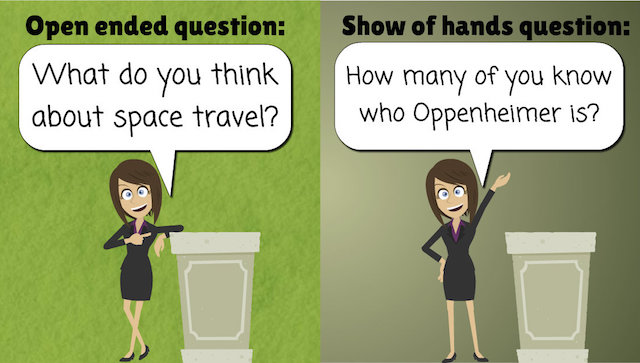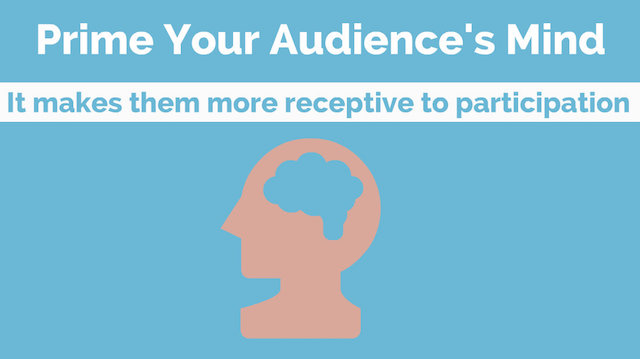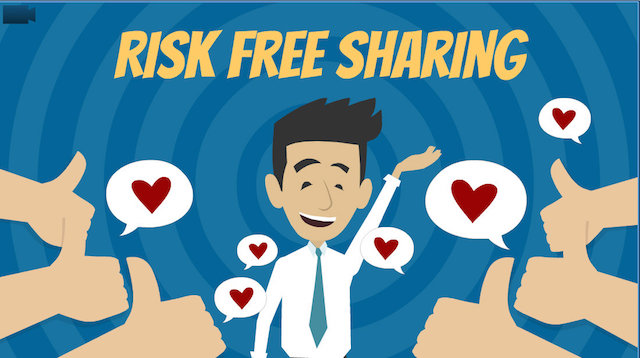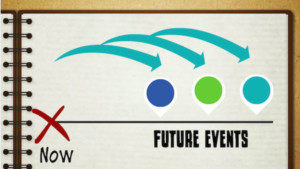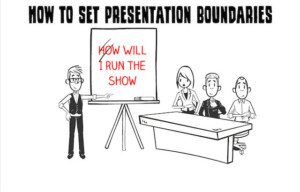So you muster every ounce of courage you have, and you ask a question hoping for audience response.
And no one answers.
What do you do? Do you give up and go back to giving a boring presentation? Or do you try again in a smarter way?
Today’s Tip-Tuesday will give you professional comebacks to use to bounce back from anxiety-inducing audience response. This will help you motivate people to engage with your question, even if they are not typically responsive.
Let’s say you have one of these questions as part of your presentation:
- Show of hands question (ex. How many of you know who Oppenheimer is?).
- Open-ended questions (ex. What do you think about space travel).
If you know that the audience is open and receptive then just ask them.
If you sense that your audience is hesitant or apprehensive, use the following strategy before asking a question:
1- Prime their mind: say something like “I have a question for you,” “I would like to ask you a question here,” or “I would like to do a little survey.”
This usually primes your audience’s minds for participation and foreshadows the way you expect them to respond throughout the presentation. As a result, they will be more prepared to participate.
2- Lower the risk
Reducing the risk means that you put your audience at ease by framing the act of answering a question in a positive and non-defensive light. People, usually don’t want to be embarrassed or be viewed as weird. Your job is to make them look good and remove the risk for them. This will increase the chance of an audience response.
You can lower the risk for your audience using one of these frames:
1. No mistake frame: People usually don’t want to make mistakes, and that’s why they don’t answer. Say something like: “there are no mistakes here,” “There is no right or wrong answer here,” or “there is no judgment here, feel free to share what comes to your mind.”
2. Humor frame: Humor disarms people. If you want to lower the risk of the answer, make a joke about it: Say something like “I promise I will not share the results with management.” I know humor could be challenging so I would recommend that you take standup comedy classes or hire a standup comedy up coach.
3. Benefits frame: people are more likely to do something if they can see an advantage. Say something like this: “ Your answer will help me customize the presentation for you.
4. Cost of the alternative frame: You can make the risk of not answering bigger than the risk of answering. You can do this by saying “I know you are smart people and not lazy, so please don’t be lazy.” I have never used this frame and I probably never will use it, but I thought I would share it with because it has value in some scenarios.
Here is an example of this used by Gary Vaynerchuk: go to 8:30 in the timeframe.
Conclusion
As you can see, there are many ways to ensure your audience replies to your questions with positive engagement. The best way to become more comfortable in doing this is to practice asking questions and setting the frame continually.
I encourage you to try this at your next company meeting, presentation, or your next Toastmasters speech. Would love to hear your thoughts, please let me know what you think in the comments below.
